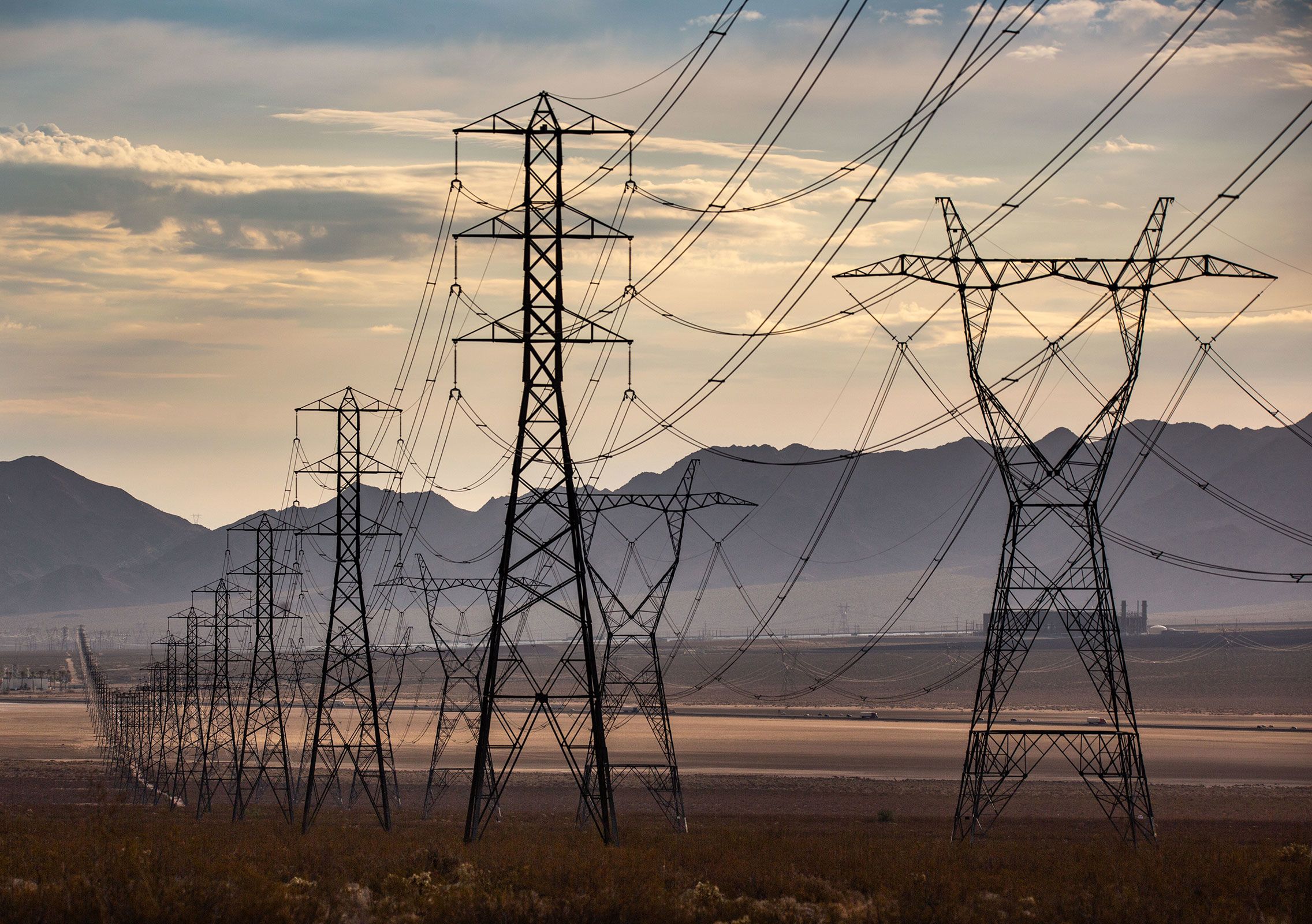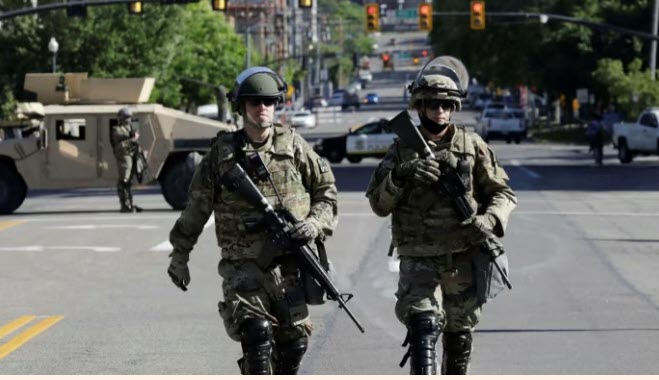< the chosen|||>

Mike Luckovich, Atlanta Journal-Constitution

< the chosen|||>

Mike Luckovich, Atlanta Journal-Constitution
There are those who say artificial intelligence will lift humankind to unimagined heights. “It’s more profound than fire or electricity”, Sundar Pichai, CEO of Alphabet Inc. (parent of Google) actually said. Others fret that it will possibly run amok and do us in. Just how is not explained, but possibly it will get rid of us by quickening climate change because we are learning that AI is a Estimates vary widely. Some suggest hysteria is setting in. Maryland-based Constellation Energy, which has contracted to supply Microsoft with nuclear energy for its data centers, projects that AI’s insatiable need for power could exceed by five or six times the amount needed to charge America’s electric vehicles. Driving demand is that the bigger the data sets that “train” AI, the better the results, but ever bigger data sets consume ever increasing power. The International Energy Agency said in a January report that a request to ChatGPT uses ten times the amount of a Google search, and that the power demanded by AI will increase ten times by just 2026. Digiconomist Is a company that tracks world digital use and exposes its unintended consequences. Founder Alex de Vries estimates that, thanks to AI alone, the amount of electricity required to power the world’s data centers could jump 50% by 2027. A peer-reviewed study by his company calculates that AI servers could use between 85 to 134 terawatt hours annually, which is about what his own country — the Netherlands — uses in an entire year, and which amounts to the entire output of about 15 average-size nuclear power plants. not just ai
AI data farms are a subset of data and computational centers (for search such as Google, Bitcoin mining, etc.) that are being created at the rate of a new one every three days, Amazon Web Services vice-president for engineering Bill Vass told The Wall Street Journal. Electricity demand to power data centers is forecast to rise by 13% to 15% compounded annually through 2030.
In the face of worldwide efforts to mitigate the emissions causing climate change, whatever gets built to supply that power will far outpace the rate that new renewable energy can be brought online. That means increased use of fossil fuels. In that same article, former U.S. Energy Secretary Ernest Moniz said, “We’re not going to build 100 gigawatts of new renewables in a few years. [We’re] kind of stuck.”
Before the AI explosion, attention to waste energy use was focused on crypto-currencies. Millions of servers around the world compute numbers non-stop day and night in a quest that one of the numbers from one of the servers at one of the crypto farms will be accepted by the Bitcoin algorithm — a game of ‘guess the number’ as de Vries puts it. As he says, those millions of Bitcoin mining devices are… “generat[ing] 500 quintillion random numbers … every single second of the day. Only once every 10 minutes [does] one participant guesses correctly…” to be rewarded with new Bitcoins. The payout can be huge, but it is a game designed to waste huge amounts of electricity calculating the quintillions of numbers that are of no use whatever.
A few years back de Vries’s firm “conservatively” estimated that the Bitcoin network was consuming 87.1 terawatt-hours (TWh) of electrical energy annually, equaling the energy usage of a country the size of Belgium. With the price of a single Bitcoin having risen inexplicably to over $63,000, uncounted numbers of hopefuls have undoubtedly piled into mining since, adding that many more TWhs of energy waste and CO2 emissions. not just fossil fuels
Through overconsumption by humans, the world’s supply of fresh water is rapidly diminishing, a threat that, absent drastic action, will lead to mass migrations and wars. So what are we doing? Building those data centers every three days that use vast quantities of water.
When Bitcoin transactions are laid against water consumption needed to cool the servers, the average Bitcoin transaction equates to some 16,000 liters. U.S. consumption could be on par with the average annual water consumption of approximately 300,000 U.S. households, equivalent to that of a city like Washington, DC.
A Google data center consumes about 4.3 billion gallons of water annually, about 450,000 gallons of water every day.
A $1.1 billion data center that began construction last July by Meta Platforms Inc (Facebook, et al.) is expected to use 665 million liters of water a year to cool the atmosphere where stacks of servers run and never turn off – as much as 195 liters a second. everything electric
Going beyond AI, Bitcoin, and data centers, the problem worsens. A principal mission of President Biden’s administration has been an assault on climate change, with almost $400 billion in the Inflation Reduction Act (IRA) allocated to clean energy, upgrading the power grid, incentives for consumers to switch to electric cars, and more.
Yet national security has dictated that the U.S. inshore the production of semiconductors. The administration’s CHIPS Act provides $50 billion for subsidies and loans so far to Micron, Qualcomm, GlobalFoundries, Intel and Taiwan’s TSMC.
But chip factories — called “fabs”, for fabricators — are voracious consumers of electricity. They can draw 100 times more power than a typical industrial business. Micron, for example, is building a new fab in upstate New York that is expected to require as much power by the 2040s as the states of New Hampshire and Vermont combined. And, of course, there is Biden’s program to do away with the internal combustion engine and cause Americans — partly by subsidy and partly by regulation — to convert to electric. To the degree successful, this will add an enormous burden on the power grid. There will be 26 million EVs on America’s roads by 2030 according to an estimate by the Edison Electric Institute. That would require an extra 100 TWhs of electricity to handle the load, which is about 2.5% more than today’s U.S grid produces. The Environmental Protection Agency (EPA) thinks its vehicle rule will result in EVs being 67% of automakers ‘ output by 2032 but it will be late in that decade before two-thirds of America’s 400 million vehicles will be electric. For that to happen, there must be something on the order of 1,000 TWhs more of electricity, which is 25% more than what the U.S. grid produces today. Those estimates don’t mention whether trucks are included in “vehicles” — trucks for which Biden’s EPA has just issued a rule that expects 60% of new urban delivery trucks and 25% of long-haul semis (18 wheelers) to be electric by 2032. That will add millions of “zero emission” trucks at charging stations where a semi will soak up seven-or-so times the amount of electricity that a typical house uses in a day. That is, if the charging stations get built. Some 1.4 million charge units will have to be installed in those stations by 2032 to accommodate the EPA mandate, about 15,000 a month. A report from S&PGlobal in January 2023 concluded that the nation will need more than 2 million would be needed by 2030. Neither is happening. Those wide differences show the difficulty in estimating: how often must the average vehicle pull into a charging station, how long on average does charging take for different vehicles in different climes, how many homes will install their own units, etc. And one neglected subject is transformers. There are as many as 80 million distribution transformers that convert bring electricity into neighborhoods. Designed for today’s loads, millions will need to be replaced and – no surprise – most are made in China. overload
All these demands for electricity raise the question of whether it is possible. In March, The Guardian reported that according to filings made to the Federal Energy Regulatory Commission … “The nation will need the equivalent of about 34 new nuclear plants, or 38 gigawatts, over the next five years to power data centers and manufacturing and electrify buildings and vehicles.” If solar, a very different estimate says that 500 gigawatts will be needed by 2035, which would require “on the order of 1,000 utility-scale solar plants” adding up to the size of New Jersey, says an analysis in National Review magazine. To find the space — and the sun — most of the bigger projects would have to be built on Bureau of Land Management terrain in the western states. The process should begin now, because the red tape of the permit-review process in the U.S. is interminable. Even if that were possible, how would we get the electricity to where it is wanted? New transmission routes would have to be built to bring electricity from solar and wind areas that have none. Much of the existing six hundred thousand miles of high-transmission lines in this country is in need of upgrade, having been built just after World War II. Biden’s IRA has funding for transmission but nowhere near enough. We covered the problems of the grid a year ago in “Biden Wants an All-Electric America. The Grid Has a Problem”, a bracing report that you can read
Apr 26 2024 | Posted in Energy & Climate | Read More »

ravenous consumer of energy. Rene Haas, chief executive of the U.K. chip design company Arm, thinks that by the end of the decade AI data centers will need as much as 20% to 25% of U.S. power needs.
< law|160|30|>
Donald Trump expects there to be riotous protests if he is elected and has let it be known that he will, the moment he is inaugurated, invoke the Insurrection Act to bring the American military into the streets of our cities to round up and detain protesters.
To reinforce that this is not his idle musing, you might recall that Trump publicly expressed regret that he did not deploy the Act to quell the unrest after the murder of George Floyd. He further said he would not hesitate to use the act in the future. He is a president who thinks the Constitution is just so many disposable words, saying in 2022 that what he fantasized was a fraudulent 2020 election “allows for the termination of all rules, regulations, and articles, even those found in the Constitution.” Invoking the Act to deploy military rule within the United States would show Putin and Xi that he is just as powerful as they, elevating himself into the exclusive club of the world’s dictators to which he has aspired.
the ultimate zombie law
The Insurrection Act of 1807, so named although it dates from even earlier, 1792, has been used responsibly by several presidents. Lincoln in 1861’s insurrection in the South; Grant to put down the first Ku Klux Klan in the 1870s; Jackson, Hayes, Grover Cleveland and others, often to intervene in 
U.S. troops in Salt Lake City.
labor disputes (on behalf of employers); Eisenhower, Kennedy, and Johnson during the civil rights movement to enforce desegregation. Most notably it was not invoked on January 6, 2021 to quash an insurrection called to action by then-president Trump
In 1992 George H. W. Bush used troops to quell riots after the police beatings of Rodney King in Los Angeles. But that provides the example that it was not at the president’s initiative. It was at the request of the California governor in accord with the first part of the Act which provides for a state’s governor or legislature to ask the president to take action when faced with out of control public disorder.
no holds barred
It is the second part of the act which puts a dangerous weapon in the hands of a president like Trump, the first president to pose such a threat. It gives the president the right to call out the army or federalize the national guard of any state…
“whenever the president considers that unlawful obstructions, combinations, or assemblages, or rebellion against the authority of the United States, make it impracticable to enforce the laws of the United States in any state by the ordinary course of judicial proceedings.”
Note that it is entirely up to the president without any legislative oversight or judicial review. Moreover, there is no time limit, no “sunset” to end the martial law.
The third section says much the same and together they give the president the sweeping discretion to decide which of obstructions, combinations, assemblages, rebellion, insurrection, domestic violence, conspiracy or any combination of choosing to justify decreeing that the military take charge over their own people.
easy fixes
Repairs to the act have been proposed. Bob Bauer, of New York University School of Law and former White House counsel to President Obama, and Jack Goldsmith, a professor at Harvard.Law School and formerly assistant attorney general under George W. Bush, have proposed fixes that badly need to be in place in time to prevent a tyranny. First, the sweeping list just cited needs to be narrowed and defined. Second, a president needs to take only upon consultation with state officials and issuance of a finding that states the case for intervention. Third, Congress should set a time limit and approve any extensions.
The Brennan Center for Justice at NYU has proffered a similar proposal with the added requirement that there be a judicial review of the president’s actions.
changes likely?
The Federalist Society, a prime mover of the Project 2025 plan to take over the government, believes in the unitary theory of the presidency which says that the president of the United States should have total power to control the entire federal executive branch. House Speaker Mike Johnson, who was discovered to be the prime mover to line up believers in the stolen 
The once president and House Speaker Johnson at Mar a Lago.
election and induce 139 Republicans to vote against certifying Biden’s election, is all in for Trump and certainly Project 2025. Johnson went to Mar a Lago for the weekend where he will receive instructions from Trump, salivates over the prospect of wielding the Insurrection Act.
So, none of these parties is inclined to diminish the president’s power conferred by the ill-conceived Insurrection Act. From all that Trump has said, we might therefore expect martial law should he win re-election even if protests are minor. It will be a disheartening outcome: a law enacted at the very beginning of the country lying in wait for 232 years to finally undermine the world’s longest running Constitution.
In a sudden turnabout, as the war reached the half-year mark, Israel has withdrawn its forces from the southern end of the Gaza Strip and ceasefire talks have resumed in Cairo. Warnings of famine from several organizations, and the killing of seven members of World Central Kitchens, a charity that had brought a shipload of food for the starving population, finally was enough for U.S. Secretary of State Antony Blinken to end months of feckless pleading by issuing an implicit threat that aid to Israel might be in jeopardy:
“Right now there is no higher priority in Gaza than protecting civilians, surging humanitarian assistance, and insuring the security of those who provide it. Israel must meet this moment…If we don’t see the changes that we need to see, there’ll be changes in our own policy.”
Whether the president would actually follow through on that veiled threat is questionable. Having immediately after the Hamas atrocities declared U.S. support of Israel to be “ironclad”, he has since had to confront what he called Israel’s “over the top” killing of Palestinian civilians and worry about a critical percentage of voters in the battleground state primaries who protested his inaction by marking their ballots “uncommitted”.
But the threat was enough to cause Israel Prime Minister Netanyahu to finally back down after months of defying Biden. Of paramount importance, hundreds of trucks, in numbers close to the 500 a day that Gaza customarily needs, have been entering Gaza in recent days.
Calling Netanyahu’s approach to the war “a mistake”, Biden said after a phone call with Netanyahu that “He agreed to do several things that related to, number one, getting more aid, both food and medicine, into Gaza” and to reducing significantly civilian casualties.
With the Palestinian health ministry saying that over 36,000 are dead, It took far too long for Biden to reach this point.
Update
It’s been four months since our “Gaza Made Uninhabitable as Uprooted Population Becomes Refugees”. The devastations of the war have only gotten worse. It is difficult to keep up with day-to-day reports. For now, a recap is more revealing about where this war has been and where it is going:
Just as it had done in October when it dropped a 2,000 pound bomb in the densely populated Jabalia refugee camp, killing dozens of civilians and obliterating city blocks in order allegedly to kill a single leader of the October 7th attack, the Israeli Defense Forces (IDF) continued to use blockbusting bombs (supplied by the U.S.) , such as in the southern Al-Maghazi neighborhood that killed dozens of the over a million Palestinians who had been ordered to move south where they would supposedly be safe. Statements that “the I.D.F. regrets the harm to uninvolved individuals” routinely followed such incidents, with promises to investigate, but the bombings continued in a campaign that gave rise to a new word — urbicide — the obliteration of a city — housing, hospitals, schools — such that there is left nothing to return to.
The civilian population has been driven to hurriedly form tent cities, ultimately jammed into Rafeh, the southernmost city, only to be told they will soon be forced to move a few clicks north again to make way for Netanyahu’s assault on Rafeh, on a date he says he has chosen but has not revealed.
People spend their days scavenging for food and foraging for wild plants. A woman tells a reporter about ground barley to make pita: “I can’t even describe how awful it tastes.” Several accounts have people grinding animal feed to make bread.
“Adults say their hair and teeth are falling out and fingernails are breaking, signs of malnutrition”, a Wall Street Journal report says. It recounts the tribulations of a family in the north, in Gaza City, who consume only water and tea some days in order to save for their children what bread they have been able to make, who otherwise stave off hunger pains by swallowing spoonfuls of ground thyme at night so they can sleep. The New York Times, in a piece about what people are going through to find food, recounts a father who…
“found a small amount of rice at a street vendor’s table, and a day later found [a] portion of flour — after a five-hour search. The discovery made the family feel festive.”
There is a lack of toilets, with lines of people waiting for an hour or more for access. There is open sewage. Cases of diarrhea among children have zoomed; all is linked to poor sanitation, according to UNICEF, the U.N. agency for children. They and the Palestine Red Crescent Society, the local affiliate of the International Committee of the Red Cross, said they have tried to bring in portable toilets, but the Israeli authorities prevented them.
“At the moment, anything that is considered construction material — mostly metal, but also sandwich panels, nails, reinforcement rods — are all banned.”
They are reduced to building sanitation facilities from what can be scavenged from the rubble of destroyed buildings.
The World Health Organization reports that hepatitis A has spread, as indicated by several thousand with jaundice. Thousands have lost limbs — about 12,000 , including about 5,000 children estimates Red Crescent, and that was only by the end of December — but, hospitals destroyed, they cannot get treatment and shortages of antibiotics mean infections turn deadly.
choke point
During all six months, Israel’s limitation of two entry points at the base of the Gaza Strip have meant that trucks must drive the length of Gaza, through a war zone, to reach the north — if not denied access by the IDF. Israel claims that it placed no limits on the amount of food that could come in, but the U.N. says that in January and February more than half of its missions to the north were denied permission on security grounds. The Red Crescent has been disallowed to deliver food or medical aid to the north since the end of November’s short cease-fire.
A freighter with 90,000 metric tons of flour paid for by the U.S. was held for weeks at the Israeli port of Ashdod because Israeli customs authorities refused to clear a shipment destined for Palestinians. In February, Israeli protesters blocked aid trucks from entering at the Kerem Shalom crossing for days.
U.N. agencies and charities suspended food delivery altogether in early February when a convoy was hit by Israeli navy fire. Only the U.N.’s World Food Program tried again. But in mid-March, instead of a military escort shepherding the WFP’s fourteen trucks as they headed north to aid the desperate, the military turned them back; they said roads were crowded and unsafe. The upshot? Crowds stormed the trucks and made off with 200 tons of food. And yet, Israel blames food shortages on the U.N. for faulty distribution.
At the end of February, thousands who had camped out overnight along the coastal road awaiting a food convoy rushed the 30 trucks when they arrived before dawn. More than 110 people died and 700 others were wounded — some trampled, some run over by the trucks trying to extricate themselves, others then shot by Israeli troops escorting the convoy. The military said most had died in the stampede, that soldiers had opened fire only “when the mob moved in a manner that endangered them.” The Gazan health ministry said the opposite, that it had been a “massacre”. Doctors at Gaza hospitals said gunshots accounted for most of the casualties.
In early March, the U.S. finally took action, dropping 38,000 military MRE (meals ready to eat) packets onto the coastal beaches. Egypt, Jordan, and Belgium also parachuted food in. It was a desperate stopgap that couldn’t possibly fill the need of 2.2 million people.
power vacuum
There was no plan for an administrative authority to take control after driving out Hamas, with the result that anarchy prevails in central and northern patches of the Strip.
Netanyahu refused to open further crossings than the two in the south at the border with Egypt until hostages were returned, thereby inflicting the collective 
punishment on the civilian population that has led to the edge of starvation. Every truck entering was thoroughly searched for supplies that might be intended for Hamas, greatly slowing aid to too few trucks a day. It took months of the Biden administration pressuring Israel to finally open a crossing in the north to bring aid to the possibly half million people there who never joined the forced migration south.
hospitals again besieged
In mid-March, Israeli forces repeated their assaults on Gaza hospitals — al Shia in Gaza City in the north, and Nassar and al-Amal hospitals in Khan Younis in the south — which Hamas fighters use as bases of operations. But thousands of displaced Palestinians find shelter in the hospital compounds. Al-Amal went of out serviced entirely when staff and patients were ordered to leave and bulldozers piled dirt into berms to seal off entrances.
Thirteen died at al Shifa, according to Gaza authorities, when the IDF cut electricity and life-sustaining machines went silent. The Israeli military said it was “avoiding harm to civilians, patients, medical teams and medical equipment”, but medical staff and patients were trapped inside for days with almost no food or water. One who escaped the hospital complex said men were detained, stripped, and interrogated by Israeli soldiers who attempted to sort out civilians from Hamas militants. Some who tried to leave the hospital were shot by Israeli soldiers as the firefight raged for days. A Palestinian teenager described bodies piled up outside al Shifa’s entrance.
The renewed battle for hospitals made clear that the Israeli strategy of total destruction as a means to kill Hamas fighters has not been all that effective. Militants had seeped back into areas the IDF controlled in the early months of the war and Israel — who evidently paid too little attention to the American experience in Iraq — was finding that they have on their hands an insurgency that probably knows no end.
starvation
Experts from the United Nations, relief agencies, and research groups — which together go by the initials IPC — concluded that famine is imminent in north Gaza, that the zone is experiencing the most acute hunger crisis of anywhere in the world.
Just prior to Netanyahu’s relenting, Cindy McCain, executive director of the World Food Program (and widow of Sen. John McCain), sounded the alarm:
“There is a very small window left to prevent an outright famine, and to do that we need immediate and full access to the north. If we wait until famine has been declared, it’s too late. Thousands more will be dead.”
UNICEF found that rapidly deepening food deprivation in the Gaza Strip was causing life-threatening “severe wasting” in children. Michael Ryan, an executive director of the World Health Organization’s health emergencies program, did not mince words: “This is a population that is starving to death.” The United Nations’ secretary general, António Guterres, called for “an immediate humanitarian cease-fire”, saying that the report of imminent famine was “an appalling indictment” of Israel.
triumph overcome by tragedy
It was a celebratory moment when the first ship to make deliveries to Gaza in almost two decades — towing a barge with about 200 tons of rice, flour, lentils, and canned tuna, beef, and chicken provided by World Central Kitchens — tied up at a makeshift pier they had made out of rubble.
Then just days later, three WCK vehicles, driving along the humanitarian corridor coastal road late at night for having been held up for hours at an Israeli checkpoint, were pursued by an IDF drone team which killed the seven workers. The military took responsibility, conducted an instant investigation, dismissed a couple of officers, and said it was a matter of misidentification — “friendly fire”, a spokesperson insistently called it.
Spain’s José Andrés, a naturalized American citizen, a world-renowned chef and restaurateur now far more world-renowned for the extraordinarily effective charity he founded, would have none of it:
“They were target [sic] systematically, car-by-car. Because they were not successful in hitting, they keep trying. This happened more than 1.5, 1.8 kilometers. This was not just bad luck situation where, oops, we dropped the bomb in the wrong place…Humanitarians and civilians should never be paying the consequences of war. This is a basic principle of humanity. At the time this looks like is not a war against terrorism anymore. Seems is a war against humanity itself.”
He posted on X, “The seven angels killed on a @WCKitchen mission in Gaza on Monday were the best of humanity.”
To be continued: claims and counterclaims, taking sides, questionable strategy, world opinion.